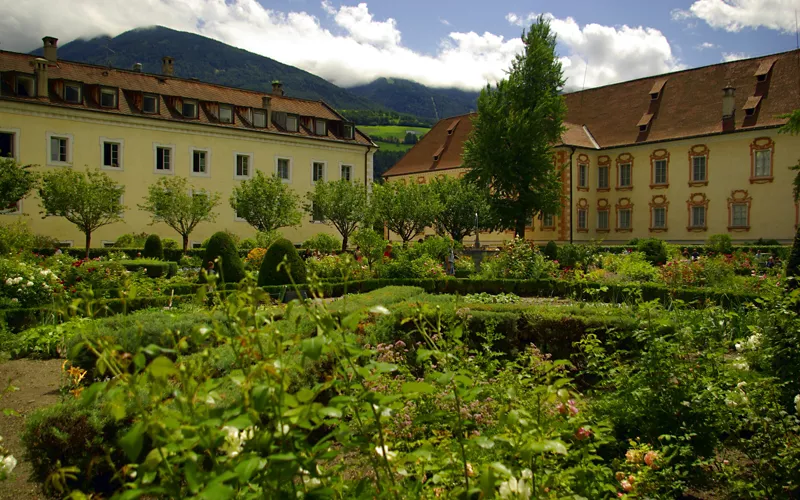This content was automatically translated. View the original text.

Overview
The Garden of Lords, a haven of peace and silence.
Perfect peace reigns in the Garden of Lords, inducing relaxation and moments of meditation. Yet we are in the very heart of Brixen, in the South Tyrol. Tyrol's oldest city reserves the surprise of silence within this verdant jewel, open to the public and with free admission.
Atmosphere of yesteryear
The Garden of Lords (Herrengarten, in German) is part of the Bishop's Palace, of which it occupies the north side. The construction of the Renaissance-style palace dates back to 1570, but the later strong Baroque influences are evident. Episcopal seat until 1973, after careful restoration it now houses the Diocesan Archive, the Museum of Cribs and the Diocesan Museum. For the clergy of Brixen, this was the place of rest, and still today the dimension is one of pleasant relaxation.
The classic Renaissance structure is expressed in the geometrically designed Italian-style garden with four regular flower beds and a precious central fountain with a bronze basin. Herbs and vegetables follow one another in decorative rows, while box hedges display roses and other ornamental plants. Lavender spreads its heady fragrance. To imagine the place as it was originally, one has to refer to the inventories, which hand down 35 orange pots and 100 wooden pots in which to plant the plants. The prince bishops were so fond of their oasis of greenery that in 1631 they granted a coat of arms to the court gardener Paul Schachner. And they were not the only ones who appreciated it. Wolfgang Amadeus Mozart also passed through here, giving a concert in the Palace's glittering Theatre Hall.
A walk through history, botany and architecture
Here you are tempted to sit for a long time, unhurriedly, on one of the many benches, in the company of a good book: no one will bother you. Or you can slowly stroll with your partner or family. Each season offers its own equally fascinating panorama. In spring, the cherry trees surrounding the park are laden with delicate blossoms, in autumn the leaves offer a colourful spectacle. And in winter, the gaze rises to the snow-capped peaks of the mountain range.
Whatever the month of your visit, the chance of finding clear skies is very high, as the Brixen area boasts 2,000 hours of sunshine a year – a true record. A historic plantation still exists today at the Garden of Lords. Although not identical to that of the past, it well reflects the overall design. This is the Pomarium, the apple orchard used to supply the bishop's table, once surrounded by walls and first mentioned in 1265. Now you can admire a dense set of rows, composed of different fruit trees, including two varieties of apple trees.
A 19th century pergola surrounds the park. A cultural curiosity is the Chinese pavilion and the Japanese tower, also from the 19th century. Here too, as in France, the fashion for exoticism had arrived, expressed in oriental-style decorations, ornaments and architecture. The wealthy curia did not want to be overtaken, showing a willingness to follow new trends.
A living herbarium
The Garden of Lords features a wide variety of medicinal, aromatic, medical and aphrodisiac herbs. It is, after all, one of the prides of this territory. The advice is to pursue this fascinating topic on a trip, visiting the many farms outside the city that cultivate and market them. You will hear of savoury, dill, marigold, chervil, lemon balm, pimpinella, evening primrose.
Herbs also enter the local cuisine, from the traditional to the more modern. The next generation of chefs compose bouquet dishes with a focus on ecology and the preservation of biodiversity. Typical dishes reign in the inns. Nettle dumplings are a delicious first course, in their peasant simplicity, as is herb soup, which to a base of shallot onion can add nettle, rowan, watercress. Among the wines, the Sylvaner, an indigenous grape variety, is worth trying.
The exploration of a natural heritage
If you want to continue your holiday by immersing yourself in nature, you can still leave the city to discover the surrounding area. The Isarca Valley offers varied agricultural landscapes, from the vineyards and orchards of the Isarco Valley to the chestnut forests of the Middle East. Further up, endless trekking routes in the Dolomites are waiting for you. UNESCO has listed the 530 kilometres of paths in the Val d'Ega, nestling between the peaks of the Catinaccio and Latemar mountains, as a World Heritage Site.